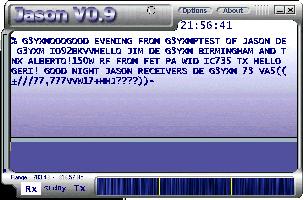Dear LF Group,
Was able to copy G3YXM's test signal last night - somewhat surprisingly
using a 300MHz IBM laptop. Copy was perfect, with random letters appearing
only when Dave was not transmitting - see attachment. Dave's signal was S9+
even at the reduced power level, and I found I had to reduce both the RX
gain and the sound card input level control until the signal did not move
the sig level bar graph to get good copy - even so, the waterfall display
showed a very wide, overloaded looking trace - but it worked fine just the
same, so a good start.
Reading Alberto's e-mail and looking at the spectrogram of the Jason signal
last night, I had not correctly understood the Jason encoding scheme when I
wrote before. Now I think I have it right - Each character is encoded as
two 4-bit nibbles, each of which is transmitted as one of 16 difference
frequencies between 2 successive tones. If the current tone is below the
centre frequency of the signal, the frequency differential is added to the
current tone frequency to get the next tone frequency. If the current tone
is above the centre frequency, the frequency differential is subtracted
from the current tone frequency. So the tone frequency will oscillate in an
irregular way around the centre frequency with the magnitude of each
frequency shift representing one 4-bit nibble. If the centre frequency is
F, and the spacing between tones is f, the possible tone frequencies are F
+/- (n-0.5)*f where n is an integer from 1...16. Therefore there are 32
possible equally-spaced tone frequencies from F-15.5f to F+15.5f. Is this
correct?
Cheers, Jim Moritz
73 de M0BMU 
|

